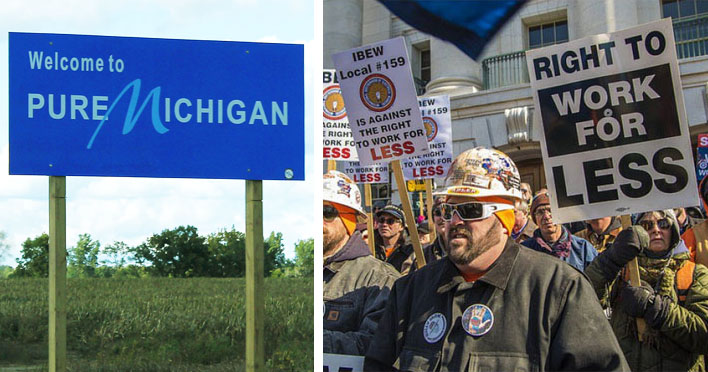NATIONAL
Why ‘right-to-work’ is wrong in Michigan—and everywhere
Restoring workers’ rights is key to reversing growing income inequality in Michigan
The following is from the Economic Policy Institute (EPI):
WASHINGTON, D.C. (March 16, 2023) — The Michigan state legislature is poised to make history this week by repealing an anti-union “right-to-work” (RTW) statute enacted in 2012. This repeal is an important step toward empowering workers to address historic levels of income inequality and unequal power in our economy, and would mark the first time a state has repealed a RTW law in nearly 60 years.
For decades, Michigan boasted the highest unionization rate in the country—and relatively higher median wages resulted for the state’s workers. In this blog post, we find that as recently as 2005, Michigan’s unionization rate was 1.69 times the national rate, and the state’s median wage was 6% higher than the national median.
But after lawmakers passed RTW in 2012, Michigan’s unionization rates declined faster than in the nation as a whole, and the state’s relative median wage fell below the U.S. median. Attacks on Michigan workers’ rights have especially benefited the rich—declines in unionization rates have been accompanied by dramatic increases in income inequality, with half of all income in the state now going to the top 10%.
The repeal of RTW in Michigan—in tandem with Illinois voters approving a constitutional Workers’ Rights Amendment (which bans future RTW laws) in 2022 and Missouri voters overwhelmingly rejecting their legislature’s attempt to impose RTW restrictions in 2018—would also signal an important turning point after a decade of extreme anti-union state legislation in the Midwest that has suppressed wages and eroded job quality.
So-called right-to-work laws perpetuate inequality and result in lower wages and benefits for all workers
 As Martin Luther King, Jr. pointed out in 1961, “right-to-work” is a “false slogan” because RTW laws provide neither rights nor work, and are in fact designed “to rob us of our civil rights and job rights [and] to destroy labor unions and the freedom of collective bargaining by which unions have improved wages and working conditions of everyone.” Decades later, research bears out King’s contention that “wherever these laws have been passed, wages are lower.”
As Martin Luther King, Jr. pointed out in 1961, “right-to-work” is a “false slogan” because RTW laws provide neither rights nor work, and are in fact designed “to rob us of our civil rights and job rights [and] to destroy labor unions and the freedom of collective bargaining by which unions have improved wages and working conditions of everyone.” Decades later, research bears out King’s contention that “wherever these laws have been passed, wages are lower.”
RTW laws are designed to diminish workers’ collective power by prohibiting unions and employers from negotiating union security agreements into collective bargaining agreements, making it harder for workers to form, join, and sustain unions. As a result, states with RTW laws generally have lower unionization rates than non-RTW states. Even after controlling for other factors that can be related to unionization (such as industry, occupation, education, age, gender, race, ethnicity, and foreign-born status), private-sector workers in RTW states are less likely to be covered by a union contract than peers in non-RTW states.
Consequently, workers in states with RTW laws have lower wages, reduced access to health and retirement benefits, and higher workplace fatality rates. Both unionized and nonunionized workers in RTW states are paid 3.1% less, on average, than workers with similar characteristics in non-RTW states, according to previous EPI research. Figure A illustrates that unionized workers are 58% more likely to have employment-provided health insurance and 65% more likely to have employment-provided retirement benefits than their nonunion counterparts.
RTW laws are historically rooted in racism and designed to maintain unequal power. When private-sector workers first gained legal protection to unionize after the passage of the federal National Labor Relations Act in 1935, unionization rates grew quickly (see Figure B). In response, anti-union, explicitly white supremacist campaigns to limit worker power and maintain Jim Crow labor relations pursued state legislation as a means to constrain workers’ newly won federal union rights via RTW policies, initially in Southern and Western states. These restrictions on collective bargaining rights have since spread to 27 states and continue to generate economic outcomes that disadvantage all workers.
State policies that reverse these legacies and empower all workers to unionize and collectively bargain should be considered top priorities for legislators in Michigan and across the country because they are fundamentally linked to key economic and labor market outcomes. Data show that unions reduce income inequality across the economy, counteract racial and gender labor market inequities, and reduce public-sector pay gaps.
ALSO at The Stand — Washington remains the 3rd most unionized state (Jan. 19, 2023) — Union membership once again meant higher wages in 2022. Median weekly earnings for union members was $1,216 last year, according to a Bureau of Labor Statistics report, compared to $1,029 per week for non-union workers. In other words, union members earned more than 18 percent higher wages. That’s the Union Difference.
JOIN TOGETHER! — If you don’t have a union at your job, learn how to join together with your co-workers and get higher wages, better benefits and respect on the job. Click here to get started.







